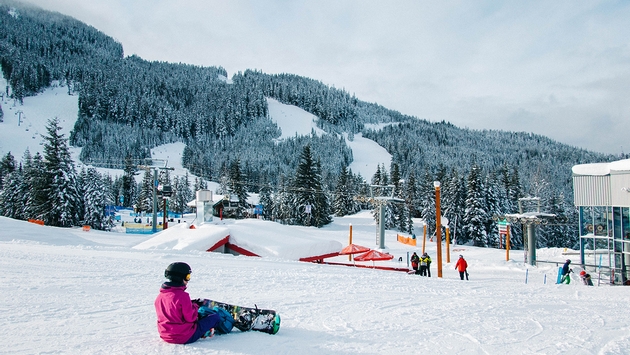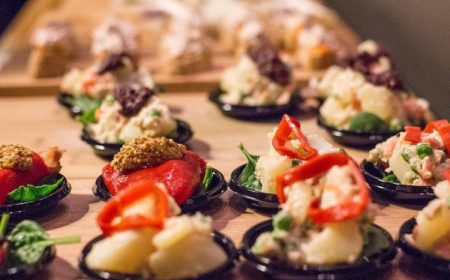
Though spring is well underway, ski season is hardly over. In Whistler, less than two hours north of Vancouver, the mountains get an average snowfall of 98 inches in March and 33 inches in April, resulting in gorgeous trails that last well into May. In fact, Whistler Blackcomb has one of the longest ski seasons in North America and even has its own permanent snow area.
Spring skiing in Whistler means gorgeous snow, blue skies and sunny days, not to mention great deals on hotels and lift tickets as well as the annual World Ski & Snowboard Festival taking place from April 10-15.
If you’re itching to hit that fresh powder and haven’t been skiing this season, Whistler is the place to go.
Where to Stay
Whistler Village has its share of hotels, but Delta Hotels by Marriott Whistler Village is by far one of the best. The contemporary hotel is located right in the village, just a quick stroll from the famed ski resort as well as several great restaurants and bars and the Whistler Olympic Plaza.
Among the hotel’s many amenities are heated outdoor hot tubs, an indoor/outdoor pool, sauna, a pub known as The Brickworks Public House, Hy’s Steakhouse, and for convenience, an on-site ski/snowboard shop.
What we love most, of course, are the rooms. The hotel boasts three different categories to accommodate small to large groups: standard rooms, one-bedroom suites, and two-bedroom suites. For a family or group of four, a one-bedroom suite offers plenty of space plus a fireplace, tub in the bathroom, a smart work desk, small balcony, and lovely robes and slippers (because you would want to do an après ski dip in the outdoor hot tub during your stay).
Ski and Snowboard
For skiing and snowboarding, head to the Whistler-Blackcomb Resort, acquired by Vail Resorts in 2016. It is one of the largest ski resorts in America, if not THE largest, combining two mountains—Whistler, which was originally developed for the 1968 Winter Olympics, and Blackcomb, which opened less than 20 years later—and featuring 240 trails. More importantly, it boasts excellent snow and elevating trails.
Thanks to its assortment of zones and terrain, the resort has trails for all skill levels. Beginners are welcome as the resort has its own Snow School that offers private and group lessons as well as ski and snowboard camp with certified instructors. Advanced and pro skiers, on the other hand, will be impressed by the intermediate and advanced terrain parks.
Whether you’re taking on the beginner trails or tackling the advanced trails (or even trying your hand at heli-skiing), don’t miss out on riding the Peak 2 Peak Gondola, a three-cable lift that links Whistler and Blackcomb and offers stunning panoramas of the mountains.
Apres Ski Activities
Give your legs and feet a break, at least for a day or two, as Whistler offers other fantastic snow-related activities.
Try your hand at snowmobiling with Blackcomb Snowmobile. If you haven’t been snowmobiling before or you’re fairly new to the sport, take their two-hour scenic tour, which starts off slow with the basics then takes you higher up on more uphill trails to their cozy mountain cable for hot coffee, a hearty breakfast and winter wonderland panoramas.
Or take to the skies for aerial views of the snow-covered valley between the two mountains by zip lining in the snow with Ziptrek Ecotours. The zip lining tour operator, which boasts several lines, suspension bridges, and platforms, offers six tours. Take the Bear Tour if you’re a beginner or the more exciting Twilight Tour.
And at the end of the day, soothe your sore muscles and unwind your mind at the Scandinave Spa. Just a stone’s throw away from town, the famously silent spa offers Whistler travelers a Scandinavian-type spa experience with its hot and cold circuit set in an idyllic, snowy setting that comes with views of the surrounding mountains.
Take a dip in its hot and cold plunge pools, relax in the sauna and steam rooms, get a massage, and then relax by the firepit with a book in your hand, all without having to deal with any unnecessary chatter or the selfie-taking bunch.
Where to Eat
While Whistler is not exactly a foodie destination, it has several restaurants that serve luscious food. You can indulge, for example, in prime steaks and seafood at Hy’s Steakhouse. Pair your dishes with fantastic cocktails like the Cucumber Martini and luscious wine.
Or enjoy a night of fine dining at Bearfoot Bistro where you can also learn the art of Champagne sabering (it’s easier and more fun than you think) in their cellar or enjoy a vodka tasting in their ice room.
Best yet, feast on the delectable fare at more than 6,000 feet above sea level with calming views of the neighboring peaks. Christine’s on Blackcomb isn’t just bells and whistling; it also makes some of the best dishes in all of Whistler.
Where to Drink
There are many bars in town, but we like The Brickworks Public House’s vibe—they have a digital jukebox inside and host live music two nights a week, cocktails and hearty plates, as well as BrewHouse’s craft beer menu. Fun flourishes throughout, including a model train that runs on the tracks just below the ceiling.
Gear You Need
For a much better ski/snowboarding experience, you must have the right gear. It might not be obvious to first time or beginner skiers, but there are some things that are an absolute necessity—to keep you warm, dry, and protected from the elements.
Base layers: Layering is important, but wearing the right layers is more important. Choose base layers that are designed to protect you from the cold. Patagonia’s Capilene Thermal Weight Crew, a Fair Trade Certified product, is lightweight and breathable yet it keeps you amazingly toasty. For bottoms, Obermeyer’s Nellie Tight helps keep your lower half very comfortable.
A jacket: Even though you’re going on a cold-weather vacation, there’s no need to overpack. One lightweight, waterproofed jacket, preferably insulated, is good enough. If you run hot, however, opt for a warm fleece vest instead.
Pants: Wearing proper ski pants is more important than anything else to keep you warm, comfortable, dry, and mobile. Patagonia makes some high quality insulated pants that fit quite nicely. They’re made of GORE-TEX® fabric with a durable water repellent finish.
Snow boots: While ski/snowboarding boots are available to rent, boots designed for snow aren’t. And you need a proper pair for when you’re snowmobiling, ziplining, or simply walking around town. The North Face’s Chilkat boots are sturdy and great for trudging on snow, while their Thermoball boots are warm, lightweight options.
Socks: Believe us; it’s not about the thickness. It’s all about the material. Get a pair of Smartwool socks instead. They’re thin, breathable, and warm.
Gloves: If you think you don’t need gloves when skiing, snowmobiling or ziplining, you’re completely wrong. A good pair of waterproofed gloves, preferably with wrist lashes, will protect your hands from frostbite.
Carry-all pack: If you’re planning on bringing your DSLR and other camera gear while skiing or doing your après ski activities—there’s nothing that compares to the views at the top of the mountains—consider a water repellent daypack that can fit other things as well like protein bars and water.


